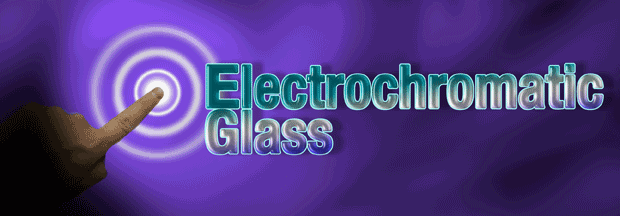
We who wear eyeglasses are familiar with lenses that change from light to dark in sunlight. A complex formula of photochromic molecules make light, dark, and every shade in between possible. Now, a similar technology, automatically tinting windows that spare occupants from glare and save energy, appears to be taking root in commercial buildings. This latter technology is based on an electric charge that triggers a color change to block sunlight and unwanted heat. It goes by several names: electrochromatic glass, electrochromic glass, smart glass, smart windows, Magic Glass, dynamic glass, and switchable glass. The supporting technology is also known as suspended particle devices (SPD), or light valves.

Source: How Stuff Works.
The promise of electrochromatic glass is that it cuts buildings' energy use by using more natural light and reducing the heating and cooling load. The drawback is its high cost. As reported in the IEEE Spectrum , a Milpitas, CA-based startup company called View, which makes “smart windows,” is teaming with Corning, the longtime maker of glass and ceramic products, to both lower the cost and improve the performance of this promising technology. View estimates that its “dynamic glass” can cut lighting by about 20% and the cooling load by 25% at peak times.
View's process involves applying two coats of ceramic metal oxide onto glass panes with a sputtering vapor deposition process. Adding a voltage causes the electrochromatic material to absorb or reflect light and darken. Similar technologies, according to the website How Stuff Works, are called suspended particle devices or light valves.
During manufacturing, panes of glass, which for View can be as large as 5 by 10 feet, are wired so they can be controlled electronically. Then they are fitted with a second pane of clear glass. The window can be operated from a wall switch, set on a schedule from a tablet or computer, or changed based on light and temperature sensors connected to a commercial building management system.
The market for this technology is worldwide. Other players include Asahi Glass (Japan), Polytronix (U.S.), Vision Systems (France), PPG Industries (U.S.), Ravenbrick (U.S.), Domoticware (Spain), Research Frontier (U.S.), DuPont (Japan), Sage Electronics (U.S.), Gentex (U.S.), Saint-Gobain (France), GlasNovations (U.K.), Scienstry (U.S.), Hitachi Chemical (Japan), SmartGlass International (U.K.), Innovative Glass (U.S.), Soladigm (U.S.), LTI Smart Glass (U.S.), SPD Control Systems (U.S.), Samsung (South Korea), and Velux A/s (Denmark).
According to the financial forecast website Markets and Markets, the future for this technology should continue to be bright until at least 2017. Its applications cover a wide market range: conventional architecture (commercial and residential), automotive, aviation, rail, and marine, and so forth. Sun-roof tops and rearview mirrors of cars are lucrative applications for smart glass. With the robust growth of cars (especially high-end cars), smart glass is also registering healthy growth in the automotive market. Partition glass in aviation is also an attractive market, where smart-glass suppliers have already received the orders from aviation market leaders.
Advertisement
Learn more about Electronic Products Magazine





